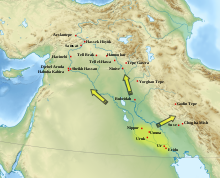Uruk expansion

The Uruk expansion is the phenomenon that the Uruk culture , which was originally restricted to southern Mesopotamia , began to spread from the middle to late Uruk period , ie from approx. 3600 BC. BC, extended beyond southern Mesopotamia. Characteristic features of this archaeological culture , such as typical ceramic shapes (especially bell pots ) and central hall houses , can then also be demonstrated in northern Mesopotamia to southeastern Anatolia and also in Iran . This is at least partly associated with settlement activity of originally South Mesopotamian population groups in these regions. So-called Uruk enclaves were formed there , similar to the later Assyrian trading posts , the most famous of which was the newly founded Habuba Kabira . It is controversial whether this was associated with major migration movements or even military undertakings. The latter is being discussed for Tell Hamoukar mainly because of the corresponding findings .
Numerous theories have been put forward to explain the phenomenon, especially in English-language archeology. Guillermo Algazes' neo-Marxist Uruk world system theory , which was massively contradicted by Gil Stein in particular, achieved fame . In addition to the aforementioned, important sites under discussion include Tell Brak , Arslantepe , Tell es-Sweyhat , Tappa Gaura , Hacinebi and Godin Tepe .
literature
- Peter MMG Akkermans, Glenn M. Schwartz: Archeology of Syria. Cambridge University Press, Cambridge 2003, ISBN 0-521-79666-0 , pp. 181 ff.
- Guillermo Algaze: The Uruk World System. Univ. of Chicago Press, Chicago 1993, ISBN 0-226-01381-2 .
- Gil J. Stein : World Systems Theory and Alternative Modes of Interaction in the Archeology of Culture Contact. In: James G. Cusick (Ed.): Studies in Culture Contact. Southern Illinois University, Carbondale 1998, ISBN 0-88104-082-7 , pp. 220-255.